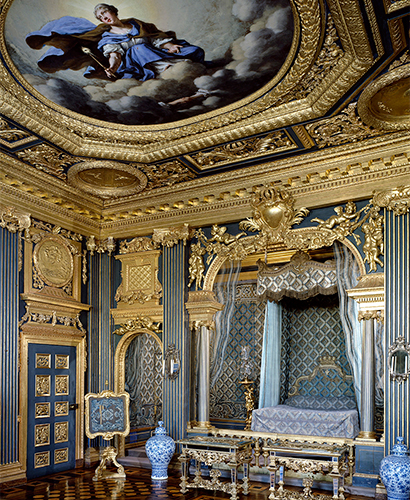
Hedvig Eleonora – Mother of the nation
Had Hedvig Eleonora been less strong in character, it is very likely that the history of Sweden would have been entirely different. Drottningholm Palace reflects a highly strong-willed, capable woman.
Hedvig Eleonora came to Sweden in 1654 to marry King Karl X Gustav. The war with Poland began immediately after the wedding, and her new husband headed off. This was a pattern that was repeated throughout her life: constant war and absent men. She was doubtless both courageous and physically strong. Their only son, Karl, was born on 24 November 1655, but shortly after Christmas she accompanied her husband to the battlefield.
Remarkable trust
Hedvig Eleonora was widowed in February 1660, at the age of just 23 and with a four-year-old son. In view of how little time they managed to spend together, the king appears to have had remarkable trust in her. His will clearly stipulated that Hedvig Eleonora should be chair and regent of the regency council for their son Karl XI. The noblemen on the council tried to out-manoeuvre her, but – to their irritation – Hedvig Eleonora attended every council meeting.
Influence and power
For much of Sweden's period as a great power, it was Hedvig Eleonora who held this power: First while her husband King Karl X was fighting military campaigns, then during the regencies of King Karl XI and her grandson King Karl XII, and finally as King Karl XII's representative in Sweden during his time abroad. She is thought to have seen it as her role in life to consolidate the power of the monarchy, and it is in the light of this that we should view her many and extensive construction projects. She built Strömsholm Palace, and as a skilled housekeeper also oversaw the fitting out of Ulriksdal Palace and Gripsholm Castle. But she is perhaps best known for having built Drottningholm Palace. Queen Hedvig Eleonora had the financial resources needed to realise her ideas, which she did together with the leading architects and artists of her time.
Great power and grand palaces
The splendour of the royal palaces became a way to confirm the power of the monarchy. This is particularly clear in Karl X's and Karl XI's galleries. They are decorated as memorial rooms, and the walls are covered with paintings depicting key battles. Another room that exudes power throughout is Hedvig Eleonora's State Bedchamber, which was used as an audience chamber for distinguished guests. The entire room is full of symbols of royal power, but there is also a more personal message. The queen commissioned her skilled court painter Ehrenstrahl to depict the history of her marriage and to convey her fear that her son would not survive. In one painting, the goddess of fate measures out his life's thread.
Relationships and commitment
Karl XI was deemed to be a sickly child, and Hedvig Eleonora therefore attached considerable importance to her son's physical training. A great deal of time was devoted to hunting and riding, and much less time to reading. Karl was probably dyslexic, evidently as a result of this focus. Throughout her life, Hedvig Eleonora was very close to her son.
"It has pleased Your Majesty to joke in a letter…"
She also had a degree of influence over her grandson Karl XII, whom she looked after following the death of his mother, Ulrika Eleonora, and she was perhaps the only one who could afford to joke with him. She repeatedly urged him to cease fighting in battle, and to return home and marry instead. On 14 December 1712, he replied from Bender, in what is now Moldavia:
"It has pleased Your Majesty to joke in a letter that I once promised to marry on reaching the age of thirty. I cannot remember at all having made such a promise, but would not dare to contradict Your Majesty on this matter. Instead, I hope that Your Majesty will see that this is early enough for a man who has reached the age of forty. Also, if I have promised any such thing, Your Majesty will certainly allow me a postponement as long as the war continues, which must be the most valid excuse possible."
On 30 November 1718, King Karl XII died on the battlefield. Perhaps he would have been wise to have listened to his grandmother a little more.
Top image: David Klöcker Ehrenstrahl's portrait of Queen Hedvig Eleonora (cropped). Photo: Royalpalaces.se

For much of Sweden's period as a great power, it was Queen Hedvig Eleonora who held this power: for her husband, her son and her grandson. She is thought to have seen it as her role in life to consolidate the power of the monarchy. The image shows an allegory of Hedvig Eleonora being crowned by the goddess Minerva. Photo: Erik Cornelius/Nationalmuseum

Building palaces was a way of cementing the royal power. Hedvig Eleonora fitted out Ulriksdal Palace and Gripsholm Castle, and built Strömsholm Palace. But she is perhaps best known for having built Drottningholm Palace. Photo: Dick Norberg/Royalpalaces.se

Hedvig Eleonora engaged the leading architects and craftsmen of the day to decorate the royal palaces. Drottningholm Palace features Baroque interiors from her time. The monumental staircase is one of the highlights, but Hedvig Eleonora's State Bedchamber is the most splendid room of all. It boasts Sweden's most lavish Baroque décor, and took fifteen years to complete. Click on the image to take a virtual tour of the State Bedchamber. Photo: Håkan Lind/royalpalaces.se

In the Ehrenstrahl Hall at Drottningholm, the queen commissioned her skilled court painter Ehrenstrahl to depict the history of her marriage and to convey her fear that her son would not survive. Hedvig Eleonora had close relationships with Karl X, XI and XII. Click on the image to see the room and its paintings in 360°.











